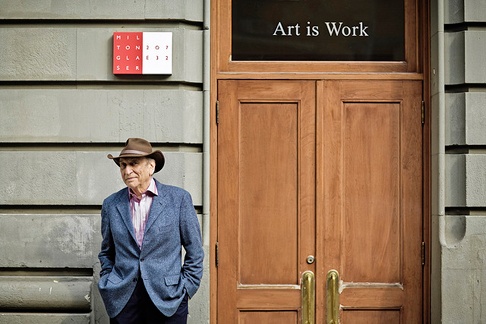10 golden rules from Milton Glazer
10 golden rules from Milton Glazer
Milton Glazer Is one of the most famous designers in the United States, an artist who has created a huge number of graphic design masterpieces, including the famous I ♥ NY logo. In addition to practice, the 80-year-old Glazer is also engaged in theory: he lectures at universities, writes essays and theoretical discussions about the relationship between design and art and their influence on each other, about the design profession and the complexities of the creative process.

1. Work only with people you like
It took me a long time to formulate this rule for myself. When I started, I thought on the contrary, that professionalism is the ability to work with any clients. But over the years it became clear that the most meaningful and good design was invented for those customers who later became my friends. It seems that sympathy in our work is much more important than professionalism.
2. If you have a choice, don’t get a job
I once heard an interview with the wonderful composer and philosopher John Cage. He was then 75. The presenter asked: “How to prepare for old age?” I have forever remembered Cage’s answer: “I have one piece of advice. Never go to work. If you go to the office every day throughout your life, one day you will be kicked out the door and retired. And then you will certainly not be ready for old age – it will take you by surprise. Look at me. Since I was 12, I have been doing the same thing every day: I wake up and think about how to earn my own bread. Life hasn’t changed since I became an old man. “

3. Avoid unpleasant people
This is a continuation of the first rule. In the 60s, there was a gestalt therapist named Fritz Perls. He suggested that in all respects, people either poison each other’s lives or feed it. Moreover, everything depends not on the person, but on the relationship. You know, there is an easy way to check how communication with someone affects you. Spend some time with this person, have dinner, take a walk, or have a drink together. And pay attention to how you will feel after this meeting – excited or tired. And everything will become clear. Always use this test.
4. Experience is not enough
I have already said that in my youth I was obsessed with professionalism. In fact, experience is another limitation. If you need a surgeon, you will most likely refer to someone who has done this particular operation many times. You don’t need someone to invent a new way to use a scalpel. No, no, no experiments, please do everything as you have always done it and as you did before you. In our work, the opposite is true – good is the one who does not repeat after himself and others. Every time a good designer wants to use a scalpel in a new way, or even decides to use a garden watering can instead of a scalpel.
5. Less is not always better
We’ve all heard the expression “less is better, but better.” This is not entirely true. One fine morning I woke up and realized that this was most likely complete nonsense. It may sound good, but in our field, this paradox does not make sense. Remember Persian carpets, would “less” be better in their case? The same can be said for Gaudí’s work, art nouveau style and much more. Therefore, I formulated a new rule for myself: it is better when everything is exactly as much as needed.
6. Lifestyle changes the way you think
The brain is the most sensitive organ in our body. It is most susceptible to change and regeneration. A few years ago, a curious story flashed in the newspapers about the search for perfect pitch. As you know, it is rare even among musicians. I don’t know how, but scientists have found that people with perfect pitch have a different brain structure – some lobes are somehow deformed. This is already interesting. But then they found out an even more interesting thing – if children 4-5 years old are taught to play the violin, there is a possibility that one of them will begin to change the structure of the cerebral cortex and develop perfect pitch. I’m sure drawing affects the brain as much as music. But instead of hearing, we develop attention. The person who draws pays attention to what is happening around him – and this is not as easy as it seems.
7. Doubt is better than confidence
Everyone talks about how important it is to be confident in what you are doing. My yoga teacher once said: “If it seems to you that you have achieved enlightenment, you are just running into your own box.” This is true not only in spiritual practice, but also in work. For me, all formed ideological positions are doubtful, because perfection is an endless development. I get nervous when someone believes in something categorically. You have to question everything. For designers, this problem appears even in the art school, where we are taught the theory of the avant-garde and that personality can change the world. In a way, this is true, but more often than not it ends up with big problems with creative self-esteem. Commercial cooperation with someone is always a compromise, and in no case should be resisted. You should always admit the possibility that your opponent might be right. A couple of years ago I read Iris Murdoch’s best definition of love: “love is the extremely difficult realization that someone other than us is real.” This is brilliant, and describes absolutely any coexistence of two people.
8. It doesn’t matter
Once for my birthday I was given a book by Roger Rosenblatt “Grow old beautifully.” I didn’t like the title, but the content interested me. The very first rule suggested by the author turned out to be the best. It sounds like this: “it doesn’t matter.” It doesn’t matter what you think – follow this rule and it will add decades to your life. It doesn’t matter if you are late or arrive on time, here you are or there, whether you said nothing or said whether you are smart or stupid. It doesn’t matter what your hairstyle is or how your friends look at you. Whether you get promoted at work, buy a new home, get a Nobel Prize, it doesn’t matter. This is wisdom!
9. Don’t Trust Styles
Style is an irrelevant concept. It’s foolish to give yourself up to any one style, because none of them deserve you entirely. For designers of the old school, this has always been a problem, because over the years, handwriting and visual vocabulary are developed. But the fashion for styles is mediated by economic indicators, that is, almost like with mathematics – you cannot argue with it. Marx wrote about this. Therefore, every ten years the stylistic paradigm changes and things start to look different. The same goes for fonts and graphics. If you plan to exist in the profession for more than one decade, I highly recommend that you be ready for this change.
10. Speak the truth
Sometimes it seems to me that design is not the best place to search for truth. Of course, there is a certain ethic in our community, which seems to have even been written down somewhere. But there is not a word about the relationship of the designer with society. They say that 50 years ago, everything that was sold with the label “veal” was actually chicken. Since then, I have been tormented by the question, what then was sold like chicken? Designers are just as responsible as butchers. Therefore, they must be careful about what they sell to people under the guise of veal. Doctors have an oath “Do no harm.” I believe that designers should also have their own oath – “Tell the truth.”
…


